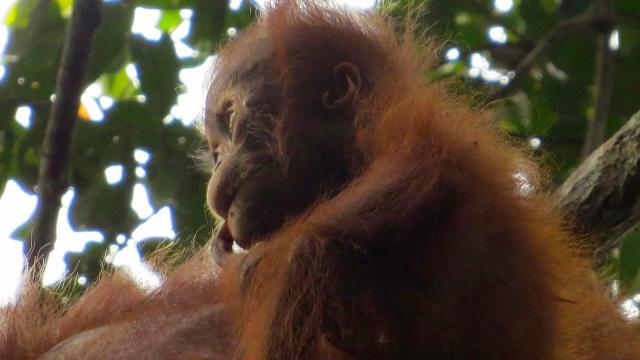With the exception of whatever weird crap humans are doing, lactation continues to be the source of food for all baby mammals on this nipple-sucking planet. When it comes down to how long mammals nurse for, though, orangutans hold the record: Six to eight years.
Image: Paige Prentice
A team of scientists from several universities set out to better understand nursing behaviour in orangutans. These primates do most of their suckling hidden in their nests, making the behaviour difficult to study. But using a technique that analyses teeth like ice cores, they found surprising complexity and important data in orangutan nursing patterns.
“Form a conservation perspective it’s important information,” the study’s first author and associate professor Tanya Smith from Griffith University in Australia told Gizmodo. “They’re very vulnerable individuals who are dependent for so long on their mothers.” Plus, “it’s also hard to imagine populations replenishing themselves naturally when it takes one female so long to raise an individual.”

Image: Tim Laman
The study’s findings not only support the fact that orangutans suckle for a long time, but shed light on why they seem to suckle in cycles as they age.
The researchers reached their conclusions by cutting slices of four immature orangutans’ teeth, looking specifically at the amount of barium the teeth accumulated over time. These scientists have previously shown that barium levels make a good proxy for nursing, where more barium means more consumption of mother’s milk. They published their most recent results in the journal Science Advances yesterday.
But what causes the new findings, that orangutans appear to nurse more during different times of the year, and for many years? Smith thought it could be that developing juveniles are responding to resource scarcity in the Indonesian rainforests they live in. Maybe it simply takes orangutans a long time to become independent enough to feed themselves an adequate amount of food. The cyclic nature of their suckling could be due to the alternating fruit and monsoon cycles. Smith wonders whether or not this behaviour is unique to orangutans. “Is it possible that other primates use milk as a fallback food when times are tough?”
Other researchers not involved with the study, like Serge Wich from the University of Amsterdam, found the study’s results impressive. Simply observing orangutans can’t confirm whether juveniles are suckling or just holding onto their mothers. “This method really leaves no doubt for that. It’s a really great approach,” he said. Smith and Wich both agreed that the sample size was fairly small, making it hard generalise to all orangutans. However, the difficulty of performing the method and the fact that it involves slicing up samples makes it tough to perform huge analyses.

Barium distribution in teeth over time in an 8.4-year-old Bornean orangutan (Image: Smith et al)
Debra Guatelli-Steinberg, professor of anthropology at The Ohio State University, had even more questions about the cycles. “Orangutans, in some instances, also exhibit annual cyclicity in the rate at which they acquire developmental defects of tooth enamel — areas of deficient enamel that result from physiological stress, such as undernutrition or disease, occurring during the period of tooth formation,” she told Gizmodo in an email. Could these cycles in tooth development also be linked to nursing behaviour?
But the results ultimately pointed the researchers towards a need for stricter conservation measures. “Indeed this whole slow life history of orangutans makes them very vulnerable for overhunting and other conservation threats,” said Wich. Ultimately, researchers could combine these findings with rainfall and other environmental data to better understand the conditions in which these endangered apes live.
As a last note, please, don’t use these results to try to forward some sort of weird parenting agenda, because we are not orangutans living in Indonesia.
“We shared an evolutionary ancestor [around] 15 million years ago,” said Smith, “in an environment different than humans.”
